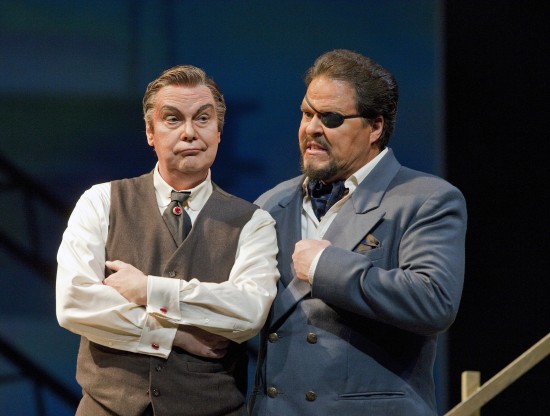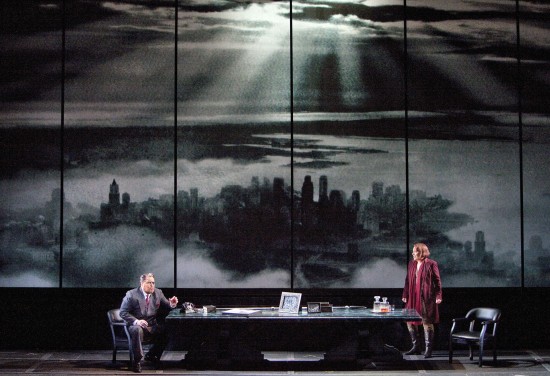Wagner, Das Rheingold, Die Walküre: Soloists and orchestra, San Francisco Opera, Donald Runnicles (conductor), War Memorial Opera House, San Francisco. 21.6.2011 and 22.6.2011 (HS)
Das Rheingold
Wotan—Mark Delavan
Loge—Stefan Margita
Alberich—Gordon Hawkins
Fricka—Elizabeth Bishop
Erda—Ronnita Miller
Mime—David Cangelosi
Fasolt—Andrea Silvestrelli
Fafner—Daniel Sumegi
Froh—Brandon Jovanovich
Donner—Gerd Grochowski
Freia—Melissa Citro
Woglinde—Stacey Tappan
Wellgunde—Lauren McNeese
Flosshilde—Renée Tatum
Die Walküre
Brünnhilde—Nina Stemme
Wotan—Mark Delavan
Sieglinde—Anja Kampe
Siegmund—Brandon Jovanovich
Fricka—Elizabeth Bishop
Hunding—Daniel Sumegi
Gerhilde—Sara Gartland
Helmwige—Tamara Wapinsky
Ortlinde—Melissa Citro
Waltraute—Daveda Karanas
Rossweisse—Lauren McNeese
Siegrune—Maya Lahyani
Grimgerde—Renée Tatum
Schwertleite—Cybele Gouverneur
Production
Conductor—Donald Runnicles
Director—Francesca Zambello
Set Designer—Michael Yeargan
Costume Designer—Catherine Zuber
Lighting Designer—Mark McCullough
Projection Designer—Jan Hartley

It was difficult to tell after performances in 2008 of Das Rheingold and last year of Die Walküre exactly where San Francisco Opera and director Francesca Zambello were going with their new production of Wagner’s Ring des Nibelungen. Zambello’s staging offered a plethora of ideas but only now, as the full cycle plays out on the War Memorial Opera stage, are they coming into focus. At the midpoint of the second of three complete cycles, my second time through these first two installments reveals strengths, both musical and dramatic.
On the musical side of the ledger, conductor Donald Runnicles continues to coax sonic glories from the pit, and Nina Stemme confirms her position as the Brünnhilde of our time. Runnicles, who led complete Ring cycles in 1990 and 1999 when he was the company’s music director, parlayed his rapport with the orchestra into many fine details en route to the big orchestral moments. His vision of the music this time seems a bit less impulsive, not quite so overtly muscular, as what we have heard from him in the past, focused more on defining each moment along the long arc of Wagner’s musical design. The musicians acquitted themselves splendidly
On the dramatic side, the staging excels by similarly distinguishing and fleshing out the highly personal stories of each character. Overall, it remains a bit of a puzzle, but in the context of other modern director-driven productions, including the much-maligned “machine” of the Metropolitan Opera’s current cycle-in-development, it serves to illuminate the story and characters. This is a plus. Zambello takes no liberties with the essence of the story, only with the trappings, by setting them closer to our own time, but in a stylized enough way that they need not be taken literally.
This time around, Zambello has been more loquacious about explaining her ideas. A director’s note in the program helps by focusing on how she wanted to draw parallels with America’s stories and myths. Rheingold is set in the California Gold Rush of 1849, in part to emphasize the opera’s theme of gods (standing in for us humans) wrenching what they want from nature. Walküre is set in the 1920s or 1930s, after World War I and the machine age, which has further despoiled nature, with the chief god Wotan portrayed as a tycoon. In Michael Yeargan’s Valhalla set, the view out the window is of a San Francisco skyline seen from above.
Zambello is also fascinated with the elements of love, redemption and reinvention. In scene after scene she focuses on the moments when love plays a role, personalizing the primal struggle at heart of the story. By all accounts those thoughts bear most strongly on the characters in Siegfried and Götterdämmerung, which I will see for the first time later this week. In Rheingold, they remain inchoate, even with some minor adjustments and improvements from what we saw three years ago. Walküre comes together much more fully.
That also seemed true of the casts. In Rheingold, despite good to excellent singing across the board, the Loge of Stefan Margita created the most indelible impression. By turns diffident and sly, the Czech tenor cut through the orchestration and made every phrase count. He is one of three holdovers from the 2008 cast, the others being Mark Delavan as Wotan and Andrea Silvestrelli as Fasolt, who deployed the richest voice of all.
Among the newcomers, the standout was Brandon Jovanovich, his bright, ringing tenor giving Froh a flashy personality. Gordon Hawkins’ Alberich fell a few decibels short of the power necessary for the character to come off as a worthy adversary to Wotan, and Melisso Citro’s Freia lacked charm. Two characters who return in later installments, Elizabeth Bishop’s Fricka and David Cangelosi’s Mime, made minimal impressions in this one. Bishop, however, returned in Die Walküre for a riveting scene as Fricka, performing it not so much a scold but as the proud, wronged wife that she is.
In Die Walküre the only holdovers from last June were Delavan and Stemme. Delavan’s Wotan here felt much more fleshed out, and he seemed more at ease this time with his bel canto approach to the music (which is what Wagner famously wanted), singing with impressive sonority and a naturalness to the text. Stemme created a Valkyrie of human scale whose every scene was riveting for its specificity and detail, singing with a creamy, almost lyric sound buoyed by what seemed like unlimited reserves of power.
Although it’s hard to top last year’s Sieglinde of Eva-Maria Westbroek, Anja Kampe came darn close. Her character seemed to build from an initial timidity, blooming with the growing love and passion she feels for Siegmund, played by Jovanovich, a significant improvement over Christopher Ventris from last year. He’s also tall and handsome, easy to see why another man’s mistreated wife might fall for him. Jovanovich was especially fine in the Death’s Announcement scene in Act II, and Kampe summon stunning power for her big moment in Act III. As well acted as Daniel Sumegi’s Hunding was, his voice lacked the dark richness to make the character truly menacing.

The highlights, after all, were the scenes with Delavan and Stemme, which reflected a palpable father-daughter connection in their looks, glances and body language. In Act II, they seemed to share a little joke at the expense of Fricka, but Wotan’s long monologue came off as very personal storytelling, a baring of the soul, rather than the stentorian proclamation it often is. Act III was simply glorious. Although the eight Valkyries weren’t quite as compelling as the group that sang the roles last year, Delavan and Stemme have grown so much in their roles that they triumphed both musically and dramatically. Brünnhilde’s plea to Wotan was gorgeously sung and Wotan’s response, leading to a heart-tugging “Leb wohl,” brought the proceedings to a peak.
Harvey Steiman